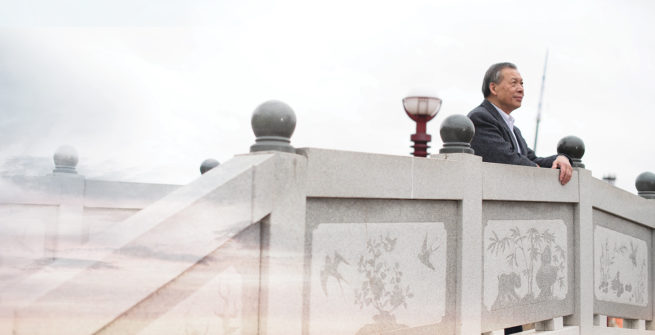January 29, 2020
Edmonton’s Chinese Garden connects East and West
The best place to stand at the Chinese Garden in Louise McKinney Park, says the garden’s society president Wing Choy, is in the middle of the bridge. There, the river valley is in full view, as are all the Chinese architectural elements — the entrance gate, a monument to Chinese pioneers, a hexagonal pavilion, rock ponds and 12 zodiac statues surrounding the rock bridge — that make up a garden that’s been in the works since the early 2000s.
It’s also the best spot in the park from a feng shui perspective, says Choy, who has been involved with the society since 2005, when the first phase of the garden was being constructed. “It’s like a throne of an emperor,” he says. “He’s sitting and overseeing the beautiful valley. It is good energy.”
The bridge could also be seen as a metaphorical connection between the East and the West, Choy says, which is one of the garden’s goals. “We want to showcase our culture to the West,” says Choy, who came to Edmonton from Hong Kong in 1970 to study engineering at the University of Alberta. “I’m trying to bridge the gap to show what the culture is all about. That’s why there is free admission.”

The City of Edmonton gave the land to the Edmonton Chinese Garden Society in 2000, and the society has since raised money to construct a garden Choy is confident will bring joy to generations of Edmontonians.
Edmonton Community Foundation (ECF), along with many other donors, has helped. In 2003, ECF donated $15,000 for the first structures,more than $39,000 in 2014 for repairs due to vandalism and $80,000 for a nine-dragon wall in 2019.
Results of the fundraising and construction efforts reflect the collaborative relationship the society wanted to foster between Canada and China. Local architect Francis Ng designed many of the structures and Canadian engineering consultant, ISL Engineering, oversaw the project.
Meanwhile, in 2002, the City of Harbin — Edmonton’s sister city in China — helped with the conceptual design and the State Department of China donated two lion statues to guard the front entrance of the garden.
The newest element, which will be installed in 2020, is the 60-foot-wide wall with nine intricate dragons — symbolizing the power of Chinese emperors — carved into it, expanding up 22 feet with the material and construction done in China. It’s an impressive piece of detailed craftsmanship and while some Western cities have them, says Choy, none has one this size.
Other pieces in the garden are just as ornate. Designed in the style of the Tang dynasty, the gazebo has a dragon painted on the ceiling and carvings in its walls. Its shape represents a grounded core, with healing energy expanding out in six directions to all parts of the world. Four dragons pursue a flaming pearl — representing luck, wealth and prosperity — on a monument dedicated to Chinese pioneers. The entrance gate lacks a physical door, to show that everyone is welcome in the garden.
Choy’s grandfather was one of the pioneers the flaming-pearl monument seeks to commemorate. He came from China to work on the Canadian Pacific Railroad, and later faced discrimination working 16-hour days in a restaurant. “[Chinese workers] always got the low-paying jobs and really couldn’t get out of it. That’s hard labour and really tough. But they didn’t complain much; just made a living and sent it home because there were hardships in China, as well,” says Choy.
Now, Choy wants to ensure Chinese culture is accurately represented and understood, as he knows what happens when it isn’t. The garden is a part of not only showcasing some of the unique aspects of the culture, but also creating strong connections between individuals in Canada and China.
“The garden will be there forever,” says Choy. And he hopes the connections it forges will be just as strong and lasting.